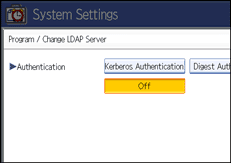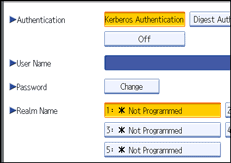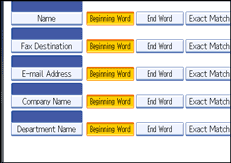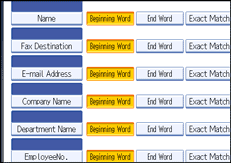Programming the LDAP server
This section describes how to program the LDAP server.
![]() Press [System Settings].
Press [System Settings].
![]() Press [Administrator Tools].
Press [Administrator Tools].
![]() Press [
Press [![]() Next] twice.
Next] twice.
![]() Press [Program / Change / Delete LDAP Server].
Press [Program / Change / Delete LDAP Server].
![]() Check that [Program / Change] is selected.
Check that [Program / Change] is selected.
![]() Select the LDAP server you want to program or change.
Select the LDAP server you want to program or change.
When programming the server, select [*Not Programmed].
![]() Press [Change] under "Name".
Press [Change] under "Name".
![]() Enter the name, and then press [OK].
Enter the name, and then press [OK].
![]() Press [Change] under "Server Name".
Press [Change] under "Server Name".
![]() Enter the server name, and then press [OK].
Enter the server name, and then press [OK].
![]() Press [Change] under "Search Base".
Press [Change] under "Search Base".
Select the root folder from which to start the search. Users registered in the selected folder and its subfolders become search targets.
![]() Enter the search base, and then press [OK].
Enter the search base, and then press [OK].
For example, if the search target is the sales department of ABC company, enter "dc=sales department, o=ABC". (In this example, the description is for an active directory. "dc" is for the organization unit, and "o" is for the company.)
Search base registration may be required depending on your server environment. When registration is required, unspecified searches will result in error.
Check your server environment and enter any required specifications.
![]() Press [Change] under "Port Number".
Press [Change] under "Port Number".
Specify the port number for communicating with the LDAP server. Specify a port that is compliant with your environment.
![]() Enter the port number using the number keys, and then press the [
Enter the port number using the number keys, and then press the [![]() ] key.
] key.
![]() Press [On] under "Use Secure Connection (SSL)".
Press [On] under "Use Secure Connection (SSL)".
Use SSL to communicate with the LDAP server.
To use SSL, the LDAP server must support SSL.
When SSL is set to [On], the port number automatically changes to "636".
SSL setting must be enabled on this machine. For details, consult your network administrator.
![]() Press [
Press [![]() Next].
Next].
![]() Select the authentication method.
Select the authentication method.
To make a search request to the LDAP server, use the administrator account for authentication.
Authentication settings must comply with your server's authentication settings. Check your server settings before setting this machine.
[Digest Authentication] is available only with LDAP Version3.0.
If you select [Cleartext Authentication], a password is sent to the LDAP server as is, without any encryption processing.
If you select [Digest Authentication], a password is sent using an encryption process that prevents passwords from being revealed during transmission to the LDAP server.
If you select [Kerberos Authentication], a password is sent using an encryption process that prevents passwords from being revealed during transmission to the KDC server where authentication occurs.
If you select [Off], proceed to step 23.
If you select [Digest Authentication] or [Cleartext Authentication], proceed to step 18 to 21, and then proceed to step 23.
If you select [Kerberos Authentication], proceed to step 18 to 22, and then proceed to step 23.

![]() Press [Change] under "User Name".
Press [Change] under "User Name".
When [Kerberos Authentication], [Digest Authentication], and [Cleartext Authentication] is selected for the authentication setting, use the administrator account name and password. Do not enter the administrator account name and password when using authentication for each individual or each search.
![]() Enter the user name, and then press [OK].
Enter the user name, and then press [OK].
Procedures for the user name setting differ depending on server environment. Check your server environment before making the setting.
Example: Domain Name\User Name, User Name@Domain Name, CN=Name, OU=Department Name, DC=Server Name
![]() Press [Change] under "Password".
Press [Change] under "Password".
![]() Enter the password, and then press [OK].
Enter the password, and then press [OK].
The user name and password are required for administrator authentication to access the LDAP server.
You can set the user name and password in this machine's Address Book to allow individual authentication access to the LDAP server. Use Administrator Tools to select the user name and password you want to use.
If you select [Digest Authentication] or [Cleartext Authentication], proceed to step 23.
![]() Select the Realm.
Select the Realm.

![]() Press [Connection Test].
Press [Connection Test].
Access the LDAP server to check that the proper connection is established. Check authentication works according to the authentication settings.
![]() Press [Exit].
Press [Exit].
If the connection test fails, check your settings and try again.
This function does not check search conditions or the search base.
![]() Press [
Press [![]() Next].
Next].
![]() Press [Change] for items you want to use as search conditions from the following: "Name", "E-mail Address", "Fax Number", "Company Name", and "Department Name".
Press [Change] for items you want to use as search conditions from the following: "Name", "E-mail Address", "Fax Number", "Company Name", and "Department Name".
You can enter an attribute as a typical search keyword. Using the entered attribute, the function searches the LDAP server's Address Book.
![]() Enter the attribute you want to use when searching for e-mail addresses, and then press [OK].
Enter the attribute you want to use when searching for e-mail addresses, and then press [OK].
The attribute value may change depending on the server environment. Check that the attribute value complies with your server environment before setting it.
You can leave items blank, but you cannot leave attributes blank when searching for e-mail addresses from the LDAP server Address Book.
![]() Press [
Press [![]() Next].
Next].
![]() Press [Change] under "Attribute".
Press [Change] under "Attribute".
![]() Enter the attribute you want to use when searching for e-mail addresses, and then press [OK].
Enter the attribute you want to use when searching for e-mail addresses, and then press [OK].
The attribute value may change depending on the server environment. Check that the attribute complies with your server environment before setting it.
![]() Press [Change] under "Key Display".
Press [Change] under "Key Display".
![]() Enter the key display, and then press [OK].
Enter the key display, and then press [OK].
The registered "Key Display" appears as a keyword for searching LDAP.
Without key display registration

With key display registration

The key does not appear on the search screen unless both "Attribute" and "Key Display" are registered. Make sure you register both to use the optional search.
![]() Press [OK].
Press [OK].
![]() Press [Exit].
Press [Exit].
![]() Press the [User Tools/Counter] key.
Press the [User Tools/Counter] key.

